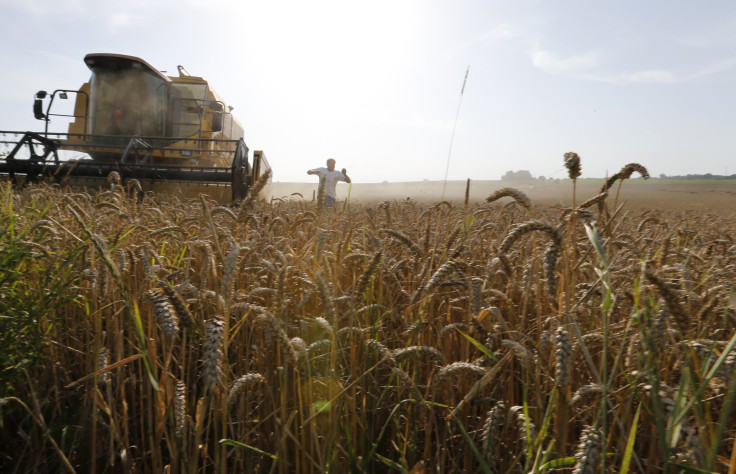Climate Change A Greater Threat To Global Food Production Than Previously Thought: MIT Researchers

Climate change could pose an even greater threat to global food production than previously thought, according to new research. Rising temperatures will not only damage heat-sensitive crops – they’ll also increase toxic air pollution, which will harm crops even further.
The study, out this week in the journal Nature Climate Change, is the first to explore how this interaction between warming temperatures and air pollution affects staple crops. Scientists have long known that the two can independently damage crops and reduce yields, but “nobody has looked at these two together,” Colette Heald, one of the co-authors and an associate professor of civil and environmental engineering at MIT, said in a statement.
She said the findings highlight the need for stronger air-quality regulations, especially given the looming global food crisis. The world is expected to need about 50 percent more food than it does today by 2050, due to population growth and the increasing demand for cereal-based diets in the developing world. But warming temperatures may reduce global crop yields by about 10 percent over that same period; left unchecked, air pollution could bump that number up even higher, the authors said.
In the past decades, scientists have increasingly focused on studying the potential effects of climate change on all aspects of life, including agriculture. Last week, a separate study by U.S. researchers found that the odds of a reduction in corn and wheat production are 20 times higher than they would be without human-induced global warming. Earlier this year, a United Nations climate change report found that falling agricultural yields would hit impoverished people the hardest.
The earth sciences field in particular has seen a big shift in how researchers study the climate, with chemists, biologists and ecosystems experts collaborating more closely than in the past. “They used to not talk to each other much, but now they have to because of these kind of [climate] impacts,” Amos Tai, an assistant professor at The Chinese University of Hong Kong and co-author of the Nature Climate Change study, told International Business Times.
For the ozone study, the MIT-affiliated researchers focused on rice, wheat, corn and soy crops, which together account for more than half of the calories that humans consume worldwide. The team observed that warmer temperatures significantly increase production of ozone, a colorless toxic gas, due to the reactions of certain chemical compounds with nitrogen oxides – greenhouse gases that come from vehicle tailpipes and power plant smokestacks.
For soybeans, the researchers found that 46 percent of damage was actually caused by increased ozone levels – and not by increased heat, as had been previously thought. About one-quarter of wheat damage and nearly 10 percent of corn damage is primarily due to ozone, while the results for rice were inconclusive, according to the study.
The interaction between temperatures and pollutants varies considerably from region to region, and each crop is affected differently, the report’s authors said. Wheat in all the major production regions is more sensitive to ozone pollution than to higher temperatures, for instance. Corn and soybeans, however, are more vulnerable to high heats.
Government policies will also play a major role in determining the extent of pollution-related crop losses. Under one scenario, the researchers projected that global food production could fall by 15 percent, but when they accounted for large emissions decreases, that figure shrank to a 9 percent drop in food production. In each region, the outcome “will depend on domestic air-pollution policies,” Heald said. “An air-quality cleanup would improve crop yields.”
The United States and parts of Asia – namely South Korea and Japan – will be least affected by the ozone-climate effect, the study found. That’s because “even in the worst-case scenario, which is business-as-usual, we still expect that ozone is going to decrease in the future because of ozone regulations in these particular countries,” Tai said in the phone interview.
China and South Asia, on the other hand, will see the most ozone-related damage to wheat, rice and soybean crops because of the chronically high levels of toxic air pollution. Even corn, which is generally more vulnerable to heat than ozone, will suffer significantly from poor air quality.
Tai said the findings should serve as a wake-up call for the government planners and agricultural experts who are working to protect the world’s food supplies from global warming. Efforts to improve irrigation in sun-scorched regions, or to replace sensitive crops with more resilient varieties, could be less effective if ozone pollution keeps dirtying the air. “If you do not control your ozone, then anything that you do through climate adaptation may not realize the full potential, because ozone will just offset your benefits,” Tai said.
The study is proof that countries should invest more in renewable sources like solar and wind energy and less in pollution-intensive fossil fuels, Denise Mauzerall, a professor of environmental engineering and international affairs at Princeton University, who was not involved in the MIT research, said in a statement. “The increased use of clean energy sources that do not emit greenhouse gases or conventional air pollutants … would be doubly beneficial to global food security, as they do not contribute to either climate change or increased surface-ozone concentrations,” she said.
© Copyright IBTimes 2024. All rights reserved.





















